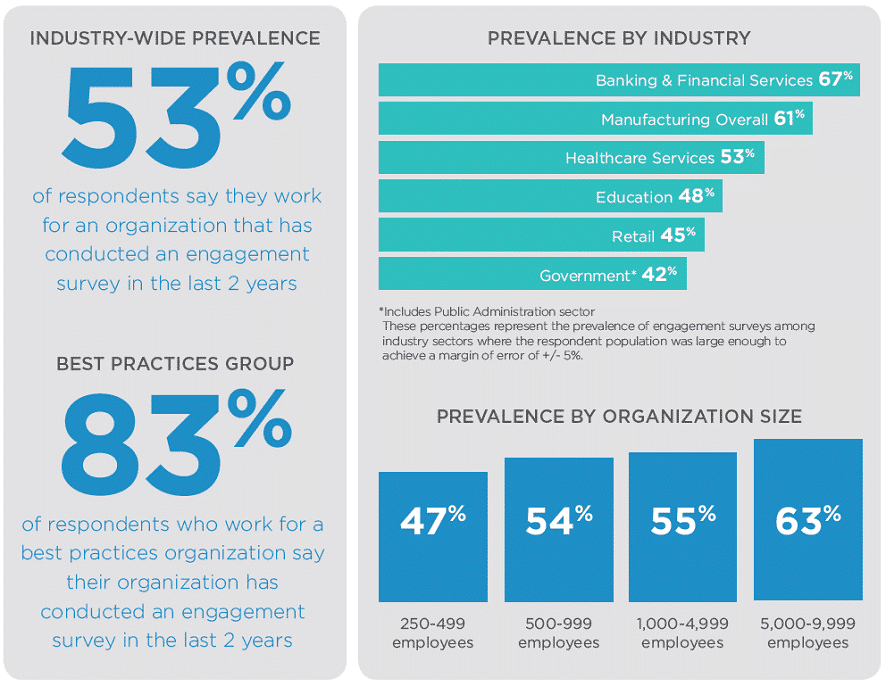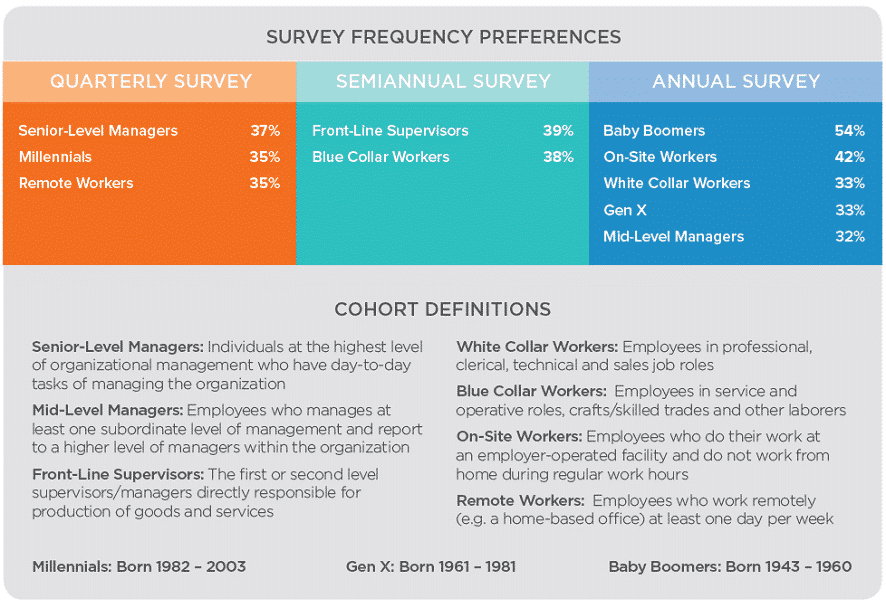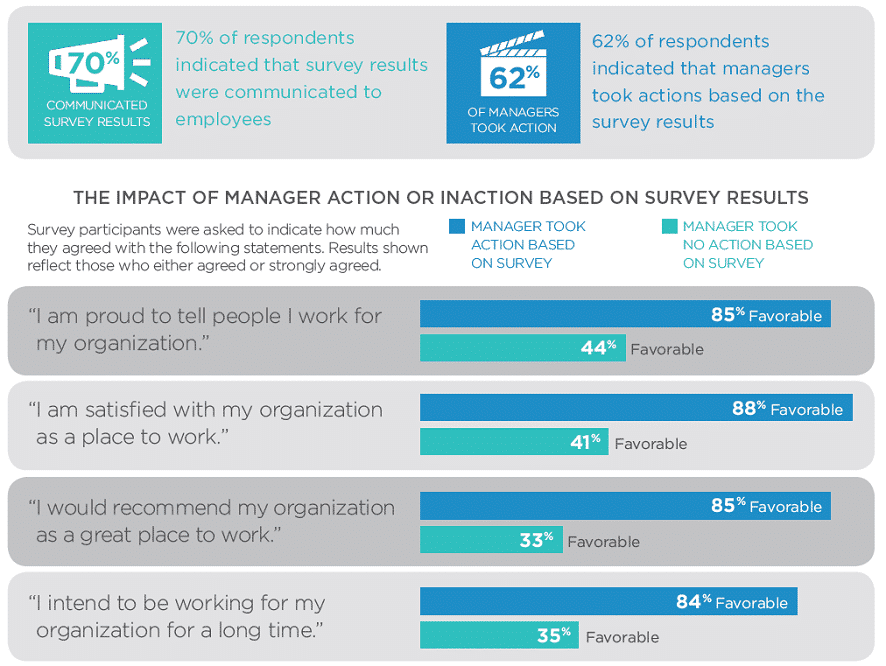What do Employees Think about Engagement Surveys?

INTRODUCTION
More than half of all organizations in the U.S. with 500 employees or more conduct employee engagement surveys. Clearly, HR departments want to know the key drivers for engagement among their employees, but what do employees have to say about engagement surveys?
To find out we contracted with an independent, third-party research company to survey 1,500 U.S. employees representing all major industries and demographic categories.
The results, documented in this report, provide new information about the prevalence of engagement surveys across different industries and company sizes, the preferences among employees and managers for the frequency of surveys and–most importantly–the influence of post-survey follow up by managers on employee perceptions and attitudes.
Employees who said their manager took action on engagement survey results show favorability levels for key engagement indicators that are, on average, twice as high as the favorability levels of employees with managers who did not take follow-up action.
This Trendicators Survey report is the result of research conducted by Engage2Excel’s Chief Scientific Officer, Dr. Jack Wiley. The results, summarized on the following pages, provide readers an unbiased view of employees’ perceptions of engagement surveys in today’s workplace.

Jack Wiley is an author, consultant, researcher and instructor. For almost three decades, he has focused on two big research questions: what employees most want, and what organizational factors best promote employee engagement, performance confidence and business success.
SURVEY RESULTS AT-A-GLANCE
53% of employers have conducted an engagement survey within the past 2 years
70% of employees indicated that the results of the engagement survey were communicated
62% of managers took action based on engagement survey results
Employers who conduct engagement surveys enjoy engagement scores that are 38% higher than those who don’t.
Survey Demographics
Number of Respondents: 1,500
Countries Represented: United States
Industries Represented: All major industries
Respondent Demographics: U.S. adult workers in all job types at organizations with at least 100 employees, with proportionate representation of gender, age group and racial/ethnic origin
Margin of Error: 95% confidence level +/- 5%
Trendicators is the research division of Engage2Excel, a leading provider of employee recognition, engagement survey and talent acquisition solutions. Trendicators provides original research along with reports on insights and best practices from industry leaders and experts.
Download
 hbspt.cta.load(123973, 'bdf1bfa4-650e-4114-b20b-790e940620d2', {});
hbspt.cta.load(123973, 'bdf1bfa4-650e-4114-b20b-790e940620d2', {});
ENGAGEMENT SURVEY PREVALENCE
How common are employee engagement surveys?
More than one-half of all companies with 500 or more employees conducted an employee engagement survey within the past two years, according to survey respondents. Employees who work for organizations that have adopted best practices for management and HR are far more likely to report experiencing an engagement survey (83%) than the overall respondent population (53%). We were surprised to find that 47% of companies with 250-499 employees conduct engagement surveys.

Download
 hbspt.cta.load(123973, 'bdf1bfa4-650e-4114-b20b-790e940620d2', {});
hbspt.cta.load(123973, 'bdf1bfa4-650e-4114-b20b-790e940620d2', {});
PREFERENCES FOR FREQUENCY OF SURVEYS
How often do employees want to be surveyed?
When survey respondents were asked how frequently they felt their organization should conduct employee engagement surveys, the response varied widely on preferences for quarterly, semiannual and annual surveys. Overall, the highest preferences were for annual (32%) and semiannual (31%) surveys.
The table below shows the highest preference by job role, age and work location status. These results indicate that many contemporary senior managers place a premium on frequently hearing the employee voice and that using the employee survey process only once a year may not be often enough. Employees likewise appreciate the opportunity to provide feedback on corporate direction, policy and workplace conditions on a regular basis.

Download
 hbspt.cta.load(123973, 'bdf1bfa4-650e-4114-b20b-790e940620d2', {});
hbspt.cta.load(123973, 'bdf1bfa4-650e-4114-b20b-790e940620d2', {});
ENGAGEMENT SURVEY INFLUENCE
How do managers’ post-survey actions affect employee attitudes?
Employee engagement surveys provide an important opportunity to improve two-way communications. However, the real value comes from the actions taken by managers in response to survey results. Among respondents who work for organizations that conduct engagement surveys, 70% said survey results were communicated to employees and 62% indicated that managers took action based on survey results. The significant impact of management action on employee attitudes can be seen in the stark differences in favorability ratings for statements that reflect high employee engagement levels.

Download
 hbspt.cta.load(123973, 'bdf1bfa4-650e-4114-b20b-790e940620d2', {});
hbspt.cta.load(123973, 'bdf1bfa4-650e-4114-b20b-790e940620d2', {});
Optimize Outcomes from Your Investment in Engagement Research
Conducting employee engagement surveys is now a common practice for a majority of companies with 250 employees or more. Engagement surveys are popular because they provide an opportunity to understand and analyze how employees feel about the workplace conditions that influence performance, loyalty and emotional connection to the organization.
The Importance of Post-Survey Action Planning by Managers
As the data on page 5 clearly demonstrate, the effectiveness of an engagement survey is determined by whether managers take action based on survey feedback.
For example, employees at organizations where managers took action based on survey results were 2.5 times more likely to recommend their organization as “a great place to work” than employees at organizations where managers didn’t take follow up action. Influencing positive employee referrals for new job candidates is just one of the many benefits of acting on survey data to improve employee engagement.
Other benefits include the opportunity to improve organizational culture by giving employees an anonymous voice to express concerns, providing managers with an objective source of feedback on how employees feel about important workplace issues, and allowing the ability to benchmark employee engagement levels internally and against industry peers.
Align Survey Frequency with Follow Up
While gaining insights on the key drivers for employee engagement is essential for improving performance and competitive advantage, surveying employees too frequently without managerial follow-up can backfire. Asking for employee opinions and not acting on them can increase disengagement.
Optimizing Outcomes
It is important to educate employees about the goals of the engagement survey upfront. Once results have been tabulated and analyzed, launch a coordinated post-survey communications and action planning process with the support of your senior leadership team:
- Benchmark comparisons reveal how your engagement levels stack up against industry peers and best-in-class companies. This provides insights into your competitive advantages and highlights opportunities for improvement.
- Structured feedback sessions let employees know their opinions matter, enable managers to focus on key priorities for improvement and help your leadership team understand root causes for why employees feel the way they do.
- Survey results and feedback sessions provide managers with detailed insights for building action plans. This enables leadership to hold managers accountable and drive organization-wide change to increase competitive advantage.